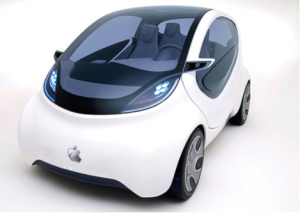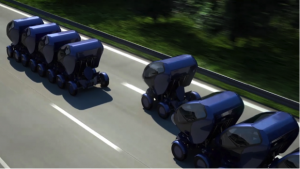(This is a short article about the Apple Car. For more reading on this topic, please see my detailed blog post on the future of the smart car.)

In February 2015 the Wall Street Journal (WSJ) published an article claiming Apple would enter the automobile market.[1 and 2] It seemed like the final confirmation of a rumour that had circulated for months, if not years, around what was then the World’s largest company and is still the most admired.[3] Since that point in time, no one has seriously disputed the existence of the project,[4] apparently codenamed ‘Titan’, which the WSJ claims is scheduled for 2019 release.[5]
Instead, speculation has turned to the car itself: What will it look like? What will it do that is different to cars today? Will it be electric? Will it be driverless? Since they appear to have entered into an agreement with BMW, will it look anything like the BMW i3 electric car? Or will it look like a minivan as speculated in the WSJ article? How will it be manufactured? What could Apple possibly do to make a profit or improve upon the 5-seated cabin on four wheels format that has dominated the ultra-competitive car industry for over a century?
Using parameters identified by leading analysts and taking the best of experimental car designs visible in the public domain, it may be possible to begin to visualise the rough envelope, and significant features of the upcoming Apple Car or other future vehicles[6] that may eventually supplant the motorcar that we know today.
I conjecture that the Apple Car, or another potential ‘disruptor’ to the established automotive industry, will have the following criteria. It will be:
- Small – perhaps shaped to fit only one or two passengers, possibly ‘in-line’, rather than abreast to make the car suitable for bicycle lane access or ‘split lane’ access (where the traditional lane width is split in two to accommodate double the traffic, but only for narrower vehicles).
- Electric – this is actually as much due to the need for ‘modularity’[7] in production and simplicity as it is for green credentials (which would be another big selling point). Electric motors are very simple, cheap, and powerful (high torque). Reliable variants are already available for electric bicycles ‘off-the-shelf’.[8] Batteries – a substantial part of the cost of electric vehicles - are likely to get significantly cheaper by 2019[9] in part due to production increase initiatives by the likes of Tesla and Panasonic.[10]
- Light (<750kg) – This is likely to be a necessity due to the types of performance characteristics Apple would need to make the car appealing to the mass markets. i.e. Capable of speeds of up to 110km/h (but no faster) using an electric motor. Note, Apple may decide to limit the speed to below 80km/h for safety reasons or because it decides travelling faster than 80km/h is ‘just unsafe’.[11]
- Manufactured using revolutionary production techniques (relative to the conventional car assembly plant ‘pressed sheet metal’ process)
- Manufactured using specially developed lighter, stronger materials enabled by the revolutionary production technique. This is an important consideration to allow people to overcome safety concerns for smaller vehicles and modes of transport. Apple has a history of commissioning bespoke materials for its products with superior aesthetic/performance characteristics e.g. ‘Gorilla Glass’ for the original iPhone, and later ‘Sapphire Glass’ presently used for smaller glass components, as well as the gold ‘alloy’ used in its ‘Edition’ Apple Watches.
- ‘Smart’ – It will of course have not only the latest entertainment capabilities a la CarPlay, but it will have the best driver/safety technologies software can provide, as seen in recent models of the Tesla cars. These will only get better with time, for example, it may later employ other technologies glimpsed in experimental/concept cars such as ‘convoying’ and ‘platooning’[12] and of course, in time become potentially self-driving or ‘driverless’.
- It may be accompanied by a different business model, e.g. a subscription service or ‘upgrade’ service.
- In ‘First World’ markets the main ‘job-to-be-done’ is likely to be a ‘short trip’ specialist (e.g. to the shops/transport hub and back) that parks easily, in more limited space, and is narrow enough to bypass some types of traffic jams. So for many it would act as an ‘economical second vehicle’ for families in more affluent societies and as a ‘sole vehicle’ for the Y-Generation and younger. In emerging markets, it may be the ‘sole commuter vehicle with the ability to expand’. The ‘ability to expand’ may come through an ability to convoy with other Apple Cars, so a family of 5 might stick 2 or 3 together for family trips.
- 200km+ range/endurance – This is to accommodate the emerging markets who would want this vehicle to act in the first instance as a commuter work-horse in the traffic jams of the large cities e.g. Beijing, Jakarta, Mumbai etc.
If you are interested in understanding how I got to this point, you can read more here.
Yen Yang is the Principal, Creative Industries for BYP Group.
To contact Yen, email yen at bypgroup dot com
References
- [1] Original source: http://yalibnan.com/2015/02/15/apple-designing-new-electric-car-codenamed-titan-report/
- [2] http://www.wsj.com/articles/apples-tiTtan-car-project-to-challenge-tesla-1423868072
- [3] http://fortune.com/worlds-most-admired-companies/
- [4] Although, to date, Apple has never confirmed the project’s existence.
- [5] http://www.wsj.com/articles/apple-speeds-up-electric-car-work-1442857105
- [6] I put in this disclaimer due to my potted history of predicting Apple products. In 2009 I predicted the shape and functionality of the rumoured Apple iPad to my fellow geek friends. I was wrong. I had inadvertently predicted something like the Microsoft Surface Tablet that came out 3 years later and not unlike the iPad Pro: https://en.wikipedia.org/wiki/Microsoft_Surface ; http://www.apple.com/au/ipad/?afid=p238%7Cs4k61cIsS-dc_mtid_18707vxu38484_pcrid_86931463222_&cid=aos-au-kwg-ipad-slid-
- [7] http://www.asymco.com/2010/11/15/law-of-conservation-of-modularity/
- [8] Bafang is one of the leading electric motor OEM’s. Costing only AU$200-400 in ‘kit form’ you will frequently see their motors repackaged under the well-known Western bicycle brands: http://www.szbaf.com
- [9] http://theconversation.com/affordable-batteries-for-green-energy-are-closer-than-we-think-28772
- [10] https://en.wikipedia.org/wiki/Gigafactory_1
- [11] Apple has a long history of making design decisions such as this, e.g. no ability to add additional slot-in memory for their idevices, incompatibility with Flash, few ports for the laptops, only one mouse button etc etc.
- [12] http://robotik.dfki-bremen.de/en/research/robot-systems/eo-smart-connecting-3.html

